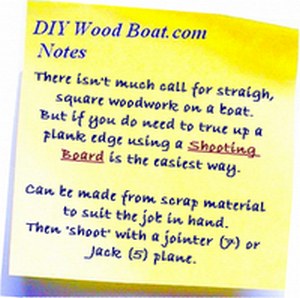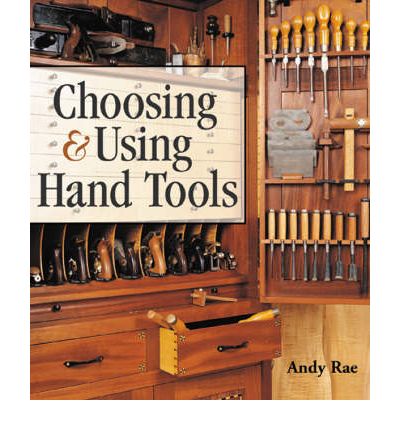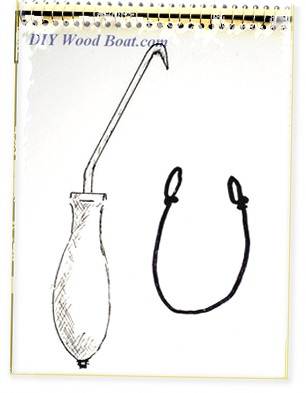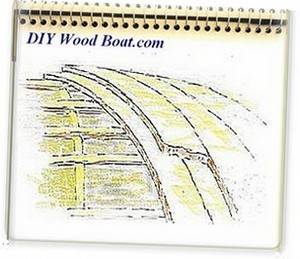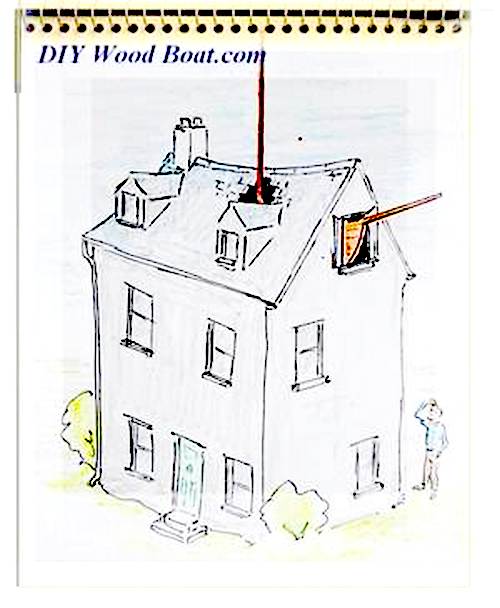Clamps / Cramps
Accumulate
as many
Clamps or Cramps as you can before
starting work on your wooden boat,
It is perfectly true that you can never have too many and preferably of all sizes and types when boat building.
For all those major
boat building jobs its best to have good quality tools as
poor cramps can cause a lot of frustration.
However, there is also a place for even those cheap plastic spring variety.
The more woodworking and boat building you do the more uses you will find for these versatile tools.
- As an extra hand for anyone working alone.
- To hold a straight-edge while marking or sawing.
- To hold pieces for accurate boring.
- To hold braces as you square up.
- To secure work while you plane or chisel.
- And of course for holding while gluing.
- And don't forget about the 'Spanish windlass' or the Wire Twister Tool.
'G' Cramps.
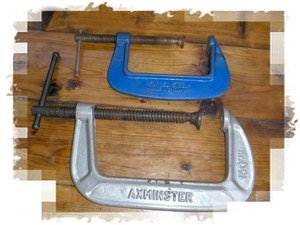 G Clamps
G ClampsThe iron 'G' cramps are the maids of all work, they are robust, available in a range of sizes, easy to use, cheap and almost indestructible.
A useful variation is the 'Edge cramp' which has an extra screw in the centre of the 'G', these are useful holding lips and curved surfaces.
The standard throat clearance is sufficient for most edge clamping.
However, deep throat or long reach versions are available.
Sizes usually refer to the maximum size of piece which can be held between pads.
These are meant to be tightened by hand using the tommy bar, using any greater leverage may damage the cramp and the work piece.
They do have a tendency to
lose their buttons, these can
be pressed back on and secured using a punch.
Always use wooden pads to protect your work.
The pads can be stuck
temporarily to the cup with a bit
of Blu-Tack while positioning.
Bar/sash Cramps.
For edge gluing panels, for bulkheads, transoms and the like there is little to beat the reach and grip provided by a sash cramp.
These are available in a range of sizes with the sliding jaw providing rapid adjustment from the maximum length right down to zero.
The screw adjusted jaw is fixed to one end of steel bar while the sliding jaw can be positioned to suit.
There are various ways in which the sliding jaw is held.
From the traditional simple through pin, to a variety of Fast action, and cam cramps.
Some have 'T' section bars for
extra
rigidity.
They have the advantage that they can be placed close together as there is no need to allow room to turn the tommy-bar.
Also available are the fast
action type where both jaws
are movable, by tightening the screw both jaws lock and jam on the
bar.
Cramp heads are also available which can be fitted on to a wooden baton.
affiliate linksPipe Cramps.
These are similar to the bar cramps in principal, but using steel piping in place of the flat bar.
One end of pipe is threaded to take the adjustable jaw, while the movable jaw can be fixed anywhere along the pipe with either a cam action leaver or with a clutch which tightens as load is applied.
Rugged hard working they normally have shallow throats, however deeper jaws can now be bought.
For some of those unusual boat building applications the pipe can be bent to fit.
Where that extra bit of pressure is required when edge setting planks, the pipe can be bent to fit the curve of the hull.
affiliate linksSpring Cramps.
Don't disregard
the cheap and cheerful spring loaded cramps, the ones that look like
big
clothes pegs.
They
are immensely useful when you want an extra hand just to hold something
in
place while figure out what to do next.
The plastic variety with their
contoured jaws, to avoid
marking your work piece, have a surprising amount of clamping power and
are so
easy and quick to position.
Use one of these when you are sawing a plywood panel to clip the end of the cut together, it will stop the ends flapping.
affiliate linksMitre Cramp.
These are specially designed to hold mitered joints together at right angles.
affiliate linksVice Grip.
These are basically the vice
grip/mole grip tool that is in every tool box.
However there are deep throat varieties which can be used by the wood boat builder.
They can be useful when lapstrake planking.
However you need to be careful of their immense clamping pressures when working with wood.
affiliate linksLapstrake Clamps.
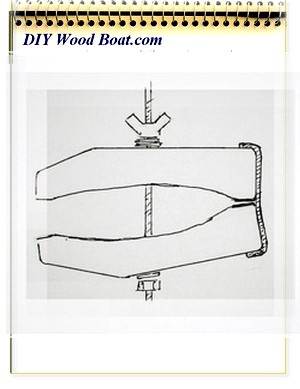
When building a lapstrake construction, tight clamping of the lap joints is essential.
Traditional style lapstrake cramps can be bought from specialist tool suppliers.
However, they are simple to make.
By making you own to order you can make them in whatever size you need.
All you need are some hardwood off cuts, some threaded studding, nuts, wing nuts and washers.
And a scrap of leather or webbing for the hinge.
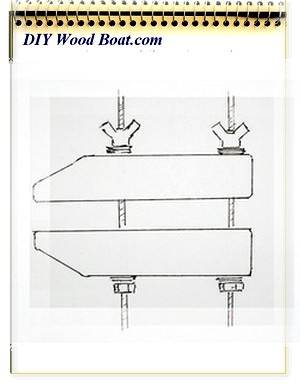
Or instead of the 'hinge' use a second length of studding.
These are handy as the jaws can be closed in a variety of angles.
The hand screw types are similar and just as easy to make.
See also John Sheen's DIY Lapstrake Cramps
affiliate links Books






